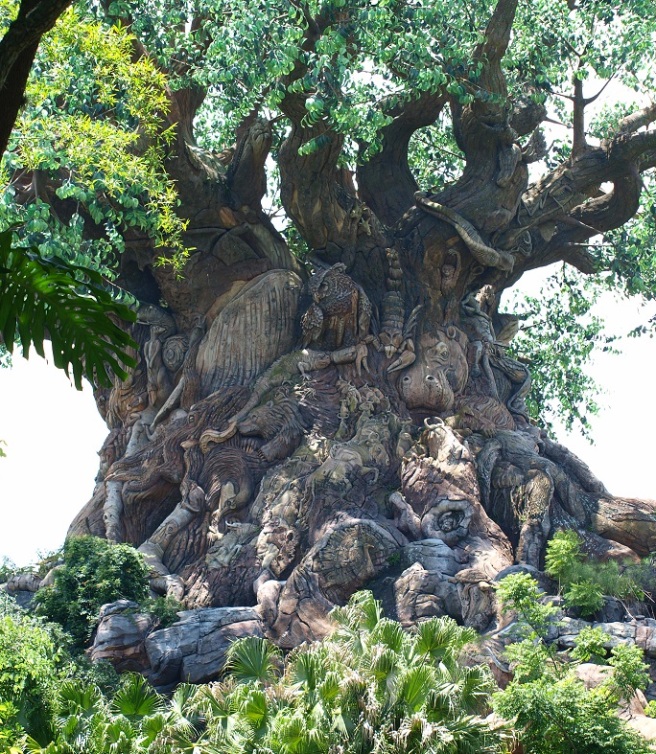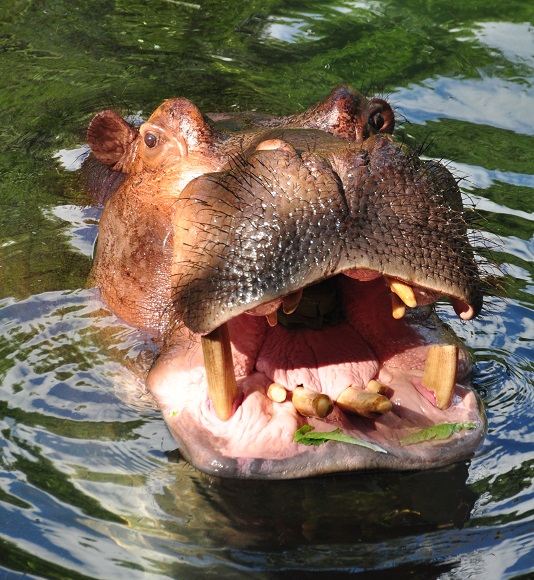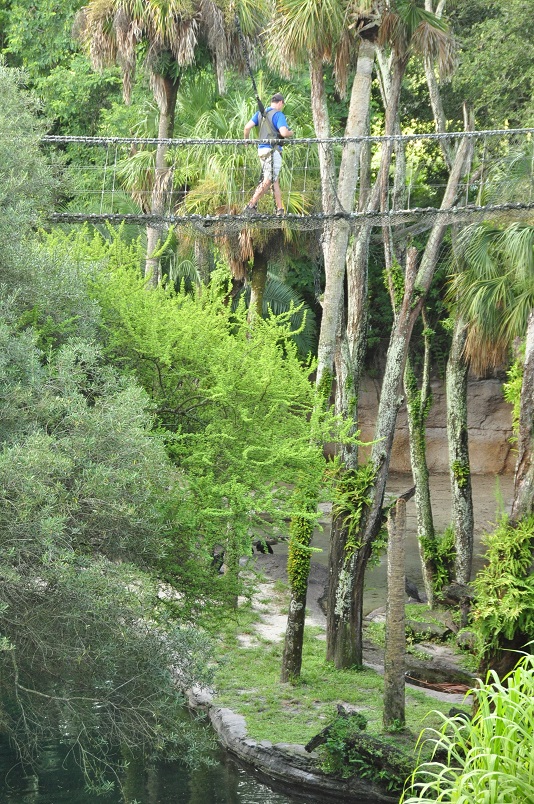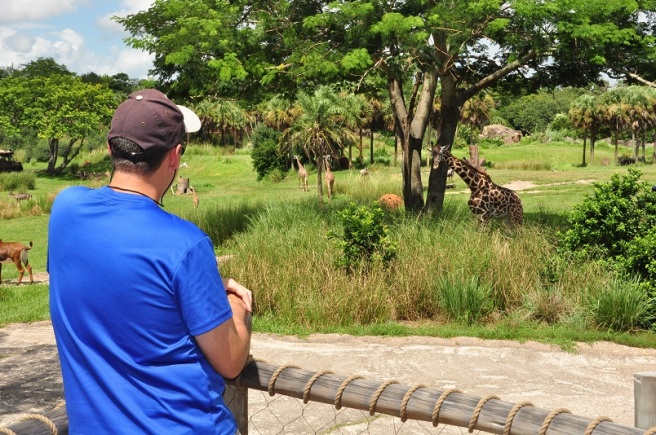
A week at Disney challenges even the hardiest of physiques; you spend an inordinate amount of time standing, walking on hard concrete, jammed into close quarters with folks who’ve perhaps not devoted as much of their energy to the maintenance of personal hygiene as you would prefer, and going from soul-sapping swamp heat to bone-chilling meat locker-grade air conditioning in as little as a single step. There comes a moment, usually on day three, when you accept that the pain in your lower back and in your arches is inevitable. Oddly, where at other vacation destinations you might resolve to spend the next day or two lounging in the pool to recuperate, at Disney World there is simply too much to do, too much to see, to let a mere trifle like physical discomfort discourage you from getting out to explore some more. It was odd, reflecting on the trip from a few weeks’ distance, realizing that although we had about seven and a half days’ worth of park time, the list of what we didn’t get to do remains astonishingly long. (Better to stoke the desire to return sooner rather than later, naturally). A quick rewind back to Day Three, however, and our third park.

Opened in 1998, Disney’s Animal Kingdom is the newest of the four major parks at WDW, and unless the Imagineers are hard at work on a secret project none of us know about, it is likely to be the last at the Orlando location, at least for some time. Animal Kingdom is light on rides; apart from the rollercoaster Expedition Everest and the simulator Dinosaur, the park is dedicated to shows, educational exhibits and animal encounters. The latter, then, is where it needed to shine, to give guests an experience they weren’t going to get at any of DAK’s elder siblings. The Magic Kingdom had long featured the Jungle Cruise ride, but the biggest drawback to it was that the animals weren’t real (Walt wanted real animals, but wasn’t able to figure out the logistics of housing them safely). Considering the preponderance of zoos in more easily accessible locations around the world, Disney had to do something extra special to compete in this realm. What else, then, but to recreate a slice of Africa in central Florida? And so we have Harambe Wildlife Reserve, and Kilimanjaro Safaris. This enormous nature preserve (over 4 million square feet) is a Noah’s Ark of living African treasures, some critically endangered in their natural home across the ocean. So typically scrupulous is the realism of the terrain, it’s said that when Disney finished building it, they invited a group of their African-born cast members for a glimpse of the attraction before it opened to the public. Upon beholding the recreated savanna for the first time, one man burst into tears and declared, “I’m home.” But you don’t have to have been born in Africa to feel a connection to this place. My wife and I had visited countless times before; we would usually ride at least three times in any given day as the sights will always be different. Normally, you board a diesel-powered truck with a dozen other guests for a 20-minute drive past the different habitats. (There used to be a story along with it as you were supposedly on an expedition to chase down poachers, but this has been wisely pared back and ultimately removed to let the natural vistas take center stage.) This time, with our son in tow, we decided to pay the extra cost to do the “Wild Africa Trek” – an intimate guided journey into the Reserve, to stuff the regular guests don’t get to see. There were supposed to be eight of us, but for whatever reason the other five folks never showed – so we got a private, three hour tour.

Conservation was a passion of the late Walt Disney himself, and Harambe Wildlife Reserve is as much a research center as it is a chance for tourists to take pictures of elephants. Our first stop along our hike was the hippopotamus pool and a meeting with Hans, the hungry hungry hippo. Hans shares a habitat with his father Henry, and is segregated from the extensive female hippopotamus population in Harambe as “Disney isn’t in the business of breeding hippos.” Said group of hippos is called a bloat, however, the collected group of females there is referred to as a pod as it isn’t considered Emily Post to make the indirect implication about a lady’s weight. The researcher who was conducting Hans’ feeding clued us in to another amazing piece of trivia about these endearingly bulbous creatures: in lieu of perspiration, the hippopotamus secretes something called “blood sweat,” a reddish fluid that contains natural sunscreen and antibiotic properties and is being studied extensively with the aim of recreating a similar substance for human use. Not that any of that would matter to Hans as he gulped down one head of Romaine lettuce after another, leaving scarcely a leaf to dear old Dad. I tell you, these young hippos with their sense of entitlement and their loud music…

Further on was a chance for us to channel our inner Indiana Jones and venture across a rope bridge hoisted high above a float of crocodiles, two of whom got into a scrap as we hovered over them. One of the smallest crocodiles, nicknamed “Lethargic” for every reason you might expect, has had his hind leg spray-painted blue so the staff can ensure he’s getting an adequate supply of food, as he tends to be muscled out of the good stuff by his larger, snappier, more ill-tempered cousins. Mindful of that scene in Live and Let Die when Bond is marooned on a small island surrounded by crocs and escapes by using their backs as stepping stones, I was deeply grateful for the cable and harness holding us securely a few feet out of range of their jaws. I’m sure even Lethargic wouldn’t pass up a meal of fresh tourist. However, ’twas not to be, and instead it was on to the second part of our tour, the drive across the savanna, where the animals are all (mercifully) herbivorous.

I’ve been trying to think of a good term to describe the savanna portion of Harambe since we’ve been back and the best I can come up with is that it’s an oasis of living miracles. Existence for the Harambe animals in their native Africa is fraught with peril and predators (some, sadly, human-shaped) but here they are free to be themselves and live quiet lives, as nature might have intended in her most idealistic mood, indeed, had she been crafting a Disney version of herself. And it always looks picture perfect; park staff go out every single night to replant literally thousands of bushes and shrubs that have been eaten and otherwise worn and torn throughout the previous day. The giraffes are particularly placid and accustomed to seeing those rolling metal boxes full of the squat little hairless creatures pointing lenses at them all day long, and they are content to wander about and do their own thing, secure in their safety. Stephanie, the affectionate reticulated giraffe on the left in the photo above, who can be distinguished by her Mickey-shaped mark just below her right ear, seems to be a born showgirl. Midway through the savanna is an observation post called “Boma,” or “safe place,” where guests on the Wild Africa Trek can stop for lunch and a chance to commune with these wonderful creatures. While we watched, Stephanie entertained us with a comedy of giraffe errors; trying to access the leaves on a high tree branch, she would pull it down with her tongue only to realize she had no arm to grab hold of it with, and watch sadly as it snapped back into place, pulling the tasty morsels far out of reach of even her statuesque neck.
As I stood beneath the hot sun, inhaling pure air, listening to nought but the steps of hooves on grasslands and smiling at Stephanie’s resolve, I felt an unfamiliar sense of ease, and of serenity, the aching feet and back retreating into distant memory. I felt the sense of belonging to the earth that is absent in the confines of the cubicle, the glass and steel of the city street, the world of the schedule and deadline and insatiable hunger for material things. Stephanie wasn’t stressing about her job, her kids, rent, politics or some lousy losing sports team (or hits and likes on her blog, for that matter). She just wanted the leaves on the tree. There was a purity to her intentions that was enviable, a clarity of purpose to be admired and replicated. I thought about some of the other animals we saw that day, like the white rhinoceros who is expected to be extinct within the next five to ten years, because of poachers killing them for their supposedly-aphrodisiac horns (you’d boost your sex drive more by eating your own fingernails, not that this fact convinces anyone). A deep sadness came over me at that moment, a fundamental recognition that we are Doing Life Wrong here on this planet. We like to think we are the masters of everything, you know, that old Genesis verse about having dominion over all life, but has acting this way made us happy? Human arrogance has only cluttered our minds with trivialities, and the more we obsess over them the more miserable we become. It’s no revelation that a walk in the woods heals the soul. We come from nature, and whenever we go back to it we are renewed. And sometimes it takes a giraffe staring at you like you’re smoking something to realize this again.

The lesson the writer takes from the Harambe Wildlife Reserve is to be a sculptor with your words – carve away the unneeded bits, the bullshit (or wildebeest shit if you prefer), and hone in on the plain emotional truth of the experience. Within the phenomenon of basic connection lies a million untold stories, and all the flash and fancy vocabulary in the universe can’t substitute for the simplicity and universality of raw feeling, like the unbridled joy in watching giraffes at play. You must be able to feel, fully and completely, before you can hope to transmit that feeling to someone else. Until then, you’re just a tourist with a camera, recording the superficiality but not the substance, and your pictures will be no more enduring than the ones of drunken Uncle Ralph with the lampshade on his head at last year’s Christmas party.
In Part IV, we visit Epcot, and go Soarin’.
